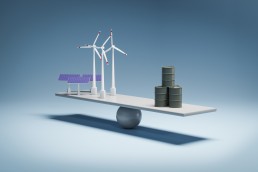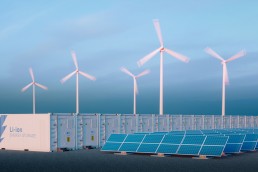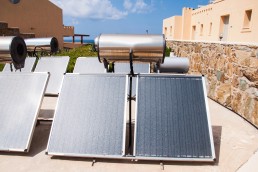At its core, being carbon-neutral means that any emissions a business creates are offset by activities such as reforestation and renewable energy investment. This doesn’t mean that companies must stop producing emissions, but they must reduce their carbon footprint and offset any remaining emissions. Becoming carbon-neutral is challenging, but there are steps to get there.
Understanding what it means and how it can benefit your company makes it easier to commit to the goal. Likewise, understanding the social and economic pressures for businesses to adopt strategies like solar power and other renewable energy sources is key. By understanding these concepts and how they involve you and your business, you can begin your journey of going green.
What does carbon neutral mean?
Carbon neutrality means calculating and compensating for your carbon emission outputs by investing in carbon offsetting projects. For example, if your business emits 100 tons of carbon dioxide annually, investing in reforestation projects that absorb 100 tons of carbon dioxide would make your company carbon neutral.
Let’s look at it from two different angles.
Carbon-neutral product or service
A carbon-neutral product or service has a net zero carbon footprint. That means that from its production until its disposal, it emits little to no greenhouse gases.
For example, a carbon-neutral product or service would be produced with renewable energy sources while considering the transportation of materials and emissions created by its production. If all of these emissions are considered and offset in some way, then that product or service is considered carbon neutral.
Carbon-neutral business
That means its operations remove as much CO2 from the atmosphere as they put in, achieving a balance often called “net-zero emissions.” It’s more about ensuring a “give and take” is happening. A common way to do this is by buying carbon offset credits.
Carbon neutrality is the big dream behind a net-zero building. A net-zero building is like an energy-saving ninja, designed and built to use the least energy possible. Any leftover energy needs are met by renewable sources on-site.
Why go carbon neutral?
Business leaders know that besides good optics, they’re participating in good causes while enjoying perks like higher profits, reduced expenses, active stakeholder participation, and decreased risks.
For instance:
– By investing in renewable energy and efficiency solutions, companies can cut down on their electricity bills in the long run.
– A carbon-neutral business communicates its commitment to sustainability and helping create a resilient future.
– By reducing their carbon footprint, businesses offset future risks like increasing energy costs and regulations on emissions.
With strategic moves like these, not only are businesses learning how to build resilience amid economic uncertainties, but they’re also learning how to think long-term in terms of sustainable finance. Companies can expect to reap the rewards for years because their operations have cut down reliance on traditional methods.
This is where sustainable finance comes in. It shows investors these initiatives are valuable — and worth their money. They also demonstrate that the business is future-proofed.
How to achieve carbon neutrality
Reaching carbon neutrality starts with a commitment from the top to make a difference and use resources responsibly. First, it’s best to define what type of carbon neutrality to aim for and what that will look like. That could be the entire organization or a specific project.
It’s also possible to get help from a certification agency or another third party to guide you through all the ins and outs. They’re dedicated to finding every possible way to find productive solutions for your operations by following these four steps to carbon neutrality:
1. Measure
First, businesses must calculate their carbon footprint. This means looking at its entire lifecycle, from raw material extraction, manufacturing, shipping and packaging, use of products, and waste.
There are three scopes of emissions.
– Direct emissions from production — emissions that come directly from your company. They result from activities you control, like fuel combustion in company vehicles.
– Indirect emissions from energy consumption — are indirect emissions that come from the energy you consume. Think about the electricity used to power your offices or the heat to keep your buildings cozy.
– Indirect emissions from upstream inputs and downstream life cycle — these indirect emissions are from sources not owned or controlled by your company.
Upstream emissions could come from producing goods or services you purchase. Downstream emissions are associated with how your products are used and disposed of once they leave your hands.
But remember, knowing your carbon footprint isn’t just about tallying these up but also about figuring out where to cut back.
2. Reduce
So you’re ready to start trimming down your footprint. Here are a few considerations to help:
– Maybe it’s time to tweak your processes or upgrade to more energy-efficient machinery.
– Consider installing solar panels on your buildings. Roof mounts can be a great option, turning unused space into an emission-reducing powerhouse.
– One strategy is to rethink your supply chain. Are there suppliers out there who are also working to limit their carbon footprint? Consider sourcing from suppliers located on sustainable energy grids.
– Computing can have a significant environmental impact, so it’s essential to choose energy-efficient options wherever possible. This could mean opting for cloud-based solutions or ensuring devices run as efficiently as possible.
Every business’s strategy will be different, but using these as a basis of understanding can help guide you.
3. Offset
There’s still more to do! Luckily, there are a few easy steps for offsetting:
– Energy Attribute Certificates. For every unit of renewable energy produced, one EAC is issued. When you buy these EACs, you’re essentially claiming that unit of renewable energy. So, while you might only be able to generate some of your energy renewably on-site, EACs let you support renewable energy production elsewhere.
– Carbon offsets. These offsets fund projects that either lower CO2 emissions or pull CO2 out of the atmosphere and store it. They could be anything from reforestation to introducing reforestation.
4. Communicate
Being open and honest about your emissions is a big deal. This honesty builds trust with your stakeholders and encourages other businesses to do the same. To help facilitate reporting, yield analysis measures how much usable energy you get from a system so you can include that information.
A carbon-neutral certification is a gold star, showing you’ve done the work. Achieving this certification involves measuring your emissions. It’s a rigorous process, but it’s also a powerful validation. Once you’ve got it, use it in your marketing to show customers that you’re a company that cares about the climate. It’s a strong message that can set you apart.
Alternatives to going fully carbon neutral
Going fully carbon neutral can be a big task and often runs into limitations like:
– Verification of reductions and offset pledges can be manipulated, and a single carbon offset can be double-counted across multiple entities, overestimating the actual impact.
– Moreover, nature-based offsets take time to realize their full potential, creating temporary imbalances that may exacerbate climate change.
– Future pledges for carbon neutrality risk economic viability, as offset prices may skyrocket due to constrained supply and increased demand.
– Net-zero targets, while commendable, often lack a clear, coordinated plan for the transformative change needed, including necessary research, investments, policies, and regulations.
There are several challenges on the way, but even if you’re not entirely carbon-neutral, you can still have an impact. Even installing solar can deliver long-term cost savings while contributing to widespread change. Moreover, it can be an easy part of your clean energy transition.
Other steps you can take are to join forces with other organizations and work together towards carbon neutrality. This can be done through collaborative research, policy changes, or funding for renewable energy projects. You could also join regulatory bodies and industry associations focusing on sustainable business practices to help drive the economy away from emissions-intensive activities.
Overall, going carbon neutral is not just a one-time goal but an ongoing commitment that requires continuous effort. By taking these steps and keeping your sustainability goals at the forefront of your business operations, you can build a more resilient future.
You might also be interested in:
October 10, 2024
Net energy metering: how does it work and what are the benefits?
Learn about net metering, how it works and its benefits for renewable energy users and the grid.
October 9, 2024
Solar lease vs. buy: which is better?
Explore the benefits and drawbacks of leasing or owning solar panels to determine the best option for your renewable energy needs.
October 8, 2024
Solar energy vs. fossil fuels: what’s the difference?
Want to understand the differences between solar energy and fossil fuels? Explore the pros and cons, including their environmental impacts and financial considerations.
October 7, 2024
Is solar power truly renewable or nonrenewable?
Discover whether solar energy is considered renewable or nonrenewable and explore the benefits of solar power for a sustainable future.
October 6, 2024
Understanding on-grid solar systems. Powering homes and businesses
Find out how grid-tied solar systems work, their advantages and why they're popular for homeowners and businesses looking to harness solar energy efficiently.
October 4, 2024
Solar energy vs. wind energy. Pros and cons
Discover whether solar energy is considered renewable or nonrenewable and explore the benefits of solar power for a sustainable future.
October 3, 2024
Achieving household energy independence
Discover how energy independence through solar power can benefit your household, reduce costs, and contribute to a sustainable future.
October 2, 2024
Solar powered water heaters. A comprehensive guide to their value and efficiency
Many people in rural areas have difficulty accessing financial services, a problem exacerbated by energy insecurity. Solar power can help protect rural communities from energy…
October 1, 2024
Separating solar energy facts from fiction
Explore common solar energy myths and facts. Learn the truth about the efficiency, costs, and environmental impact of solar power in this guide.
September 30, 2024
Essential solar panel maintenance for peak performance
Learn key strategies for solar panel upkeep, from regular cleaning to performance monitoring. Maximize efficiency and extend system life.
September 27, 2024
Understanding smart power grid technology
Discover how smart grids modernize power systems, enhance efficiency and integrate renewable energy sources for a sustainable future.
September 26, 2024
Why do solar panels degrade?
How and why do solar panels degrade? Explore the factors contributing to their lifespan and what measures to take to extend it.
September 25, 2024
Solar panel and battery recycling
Learn effective techniques for recycling solar panels and batteries. Discover sustainable practices, legal requirements, and the environmental impact of proper disposal methods.
September 24, 2024
Will urban air transportation become widely available?
Learn about the latest innovations and practices that can further improve the sustainability of climate-resilient crops, benefiting both farmers and the environment.
September 23, 2024
Emerging innovations in unmanned systems
Unmanned systems can perform various tasks without the hands-on operation of a human, although they’re often operated remotely. These systems are increasingly being used in…
















